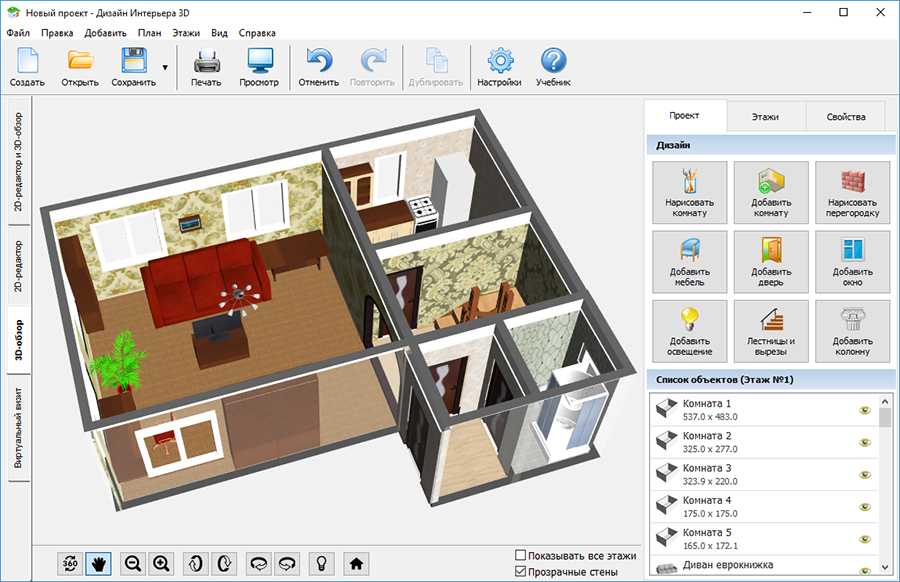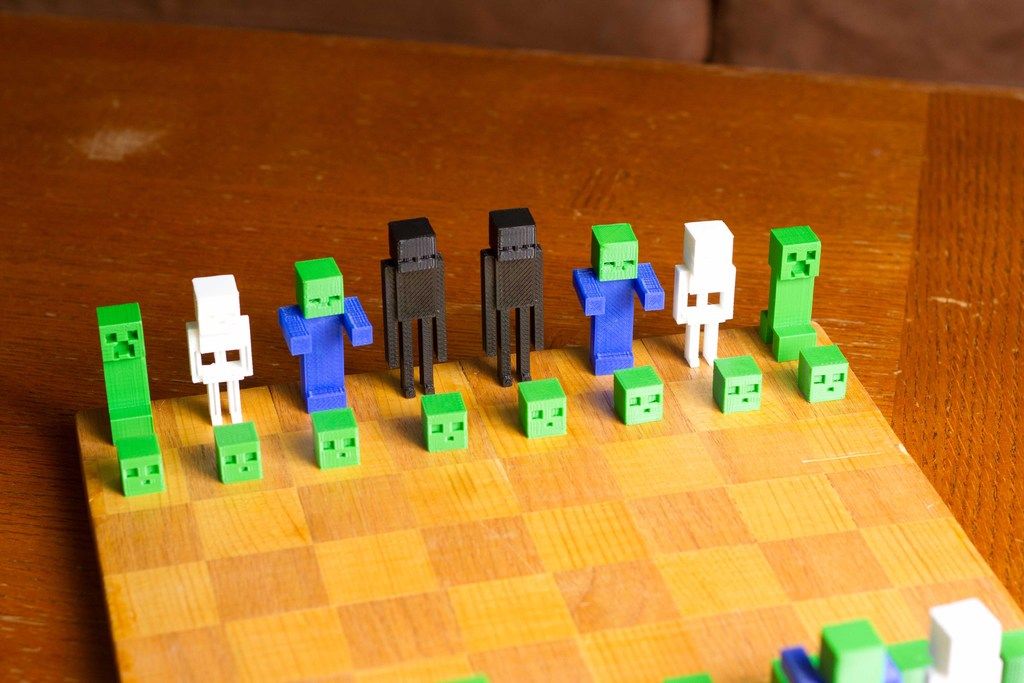3D cheese printer
3D-Printed Cheese Is Gooey, Melty and Probably Delicious
3D-printed cheese can hold its own against regular processed cheese, pictured here. (Image credit: Binh Thanh Bui/Shutterstock)Any way you slice it, cheese is considered by many to be a favorite food, whether cut into cubes as a snack, grated over pasta, layered in a sandwich or melted as a topping for pizza.
This beloved dairy treat can transform easily from a solid to a gooey liquid and back to a solid again. So it should come as no surprise that cheese is also a candidate for experiments with food and 3D printers. These projects involve squeezing a gel, paste or semiliquid material through a nozzle to shape it into a solid — and edible — object.
In a recent study, scientists 3D-printed cheese and conducted a series of tests evaluating its texture, resilience and "meltability," to see how this cheese from the future would stack up — on a structural level — against regular processed cheese. [3D Printing Cheese for Science | Video]
The inspiration for the researchers' investigation was a question posed by a cheese manufacturer, who wondered how cheese might be used as a raw material in kitchens that are likely to be equipped with 3D printers in the not-so-distant future, study co-author Alan Kelly, a professor in the School of Food and Nutritional Sciences at University College Cork in Ireland, told Live Science in an email.
Kelly was familiar with 3D printing and had studied cheese and dairy projects for 20 years, but this was the first time he'd thought to bring the two together, he said.
"It was a very speculative question which made me very curious," Kelly said. "We actually started by trying lots of cheese types, but found processed cheese to work best."
Processed cheese is produced using techniques that 3D printing mimics very closely —mixing ingredients and molding them into a new shape. And 3D-printing cheese could provide valuable insight for engineers who are still developing materials for 3D printing, which need to be fluid enough to flow through a nozzle but also capable of settling into "a buildable shape and structure," Kelly explained.
The scientists melted processed cheese at 167 degrees Fahrenheit (75 degrees Celsius) for 12 minutes, and then ran it through a 3D printer using two different extrusion rates — in other words, varying the speeds at which the printer pushed the molten cheese out through the syringe. They compared the 3D-printed results to processed cheese that had been melted and then cooled in a cylinder, and to processed cheese that was unchanged from its original solid state.
They compared the 3D-printed results to processed cheese that had been melted and then cooled in a cylinder, and to processed cheese that was unchanged from its original solid state.
Cheese that was 3D printed was 45 percent to 49 percent softer than the untreated processed cheese, the study authors found. They also discovered that 3D-printed cheese was a little darker in color, a bit springier and more fluid when melted, though it melted at approximately the same temperature as untreated cheese, according to the study.
Now that the 3D-printed cheese hurdle has been cleared, Kelly and his colleagues are testing other types of dairy products that can be 3D-printed.
"We are using mixtures of milk proteins at present to build a product, perhaps a high-protein snack, from the basics up, and designing recipes which might work best for [a] 3D printer," Kelly said. "We are pretty early on to generalize about different food systems, but that makes printing really exciting, as there is enormous potential to explore and innovate. "
"
Innovation and exploration aside, what does 3D-printed cheese taste like? Alas, the samples were too small for detailed sensory analysis, so that question remains unanswered until it can be addressed in future studies, Kelly said.
"But we don't expect any changes in taste," he told Live Science.
The findings were published online Feb. 8 in the Journal of Food Engineering.
Original article on Live Science.
Mindy Weisberger is a Live Science editor for the channels Animals and Planet Earth. She also reports on general science, covering climate change, paleontology, biology, and space. Mindy studied film at Columbia University; prior to Live Science she produced, wrote and directed media for the American Museum of Natural History in New York City. Her videos about dinosaurs, astrophysics, biodiversity and evolution appear in museums and science centers worldwide, earning awards such as the CINE Golden Eagle and the Communicator Award of Excellence. Her writing has also appeared in Scientific American, The Washington Post and How It Works Magazine.
Her writing has also appeared in Scientific American, The Washington Post and How It Works Magazine.
Behold, The Easy Cheese 3D Printer! - 3DPrint.com
One area within the 3D printing space which may be a bit slow to catch on, is that of food printing. Companies like Natural Machines have unveiled systems which will enable anyone to print intricate patterns with paste-like foods such as Nutella, pancake mix, and cookie dough. I think there is probably something about a machine printing out food which still needs to catch on before such culinary techniques really take off. With this said, what if there was a machine that didn’t require a user to fill up a print cartridge that would then be used to extrude the food from. What if it automated an extrusion process which thousands of Cheese-loving people do every day?
That’s exactly what one man named Andrew Maxwell-Parish had been wondering. Maxwell-Parish, who manages a creative technology and interactive electronics maker space at California College of the Arts, has a knack himself for making incredible gadgets. As a graduate of mechanical engineering at the University of Minnesota, many of his projects are well ahead of their time. Among them; Messenger Bags, Booty Box, Wu-Tang Can, and now the Easy Cheese 3D Printer.
As a graduate of mechanical engineering at the University of Minnesota, many of his projects are well ahead of their time. Among them; Messenger Bags, Booty Box, Wu-Tang Can, and now the Easy Cheese 3D Printer.
Fairly self explanatory, the Easy Cheese 3D Printer fabricates food items using an Easy Cheese aerosol-like can. Built on a Cartesian-style 3D printer frame with three axes, the printer’s movements are controlled in a similar fashion to any FDM/FFF 3D printer you may have seen on the market. That’s where the similarities end, however.
Instead of utilizing a heated nozzle extrusion system, or a pump-based paste extruder, Maxwell-Parish took the cheap, easy and clever way out. I’m sure we are all familiar with Easy Cheese. Concealed in a bottle, which when the white nozzle is pressed, yummy cheese comes squirting out onto whatever culinary creation one is making. Maxwell-Parish utilized these aerosol-like bottles as his extrusion system for his printer.
The printer has an arm-like mechanism, which Maxwell-Parish 3D printed himself. The computer tells the arm to move whenever cheese is to be extruded, and the arm proceeds to pull the nozzle toward itself, activating the flow of cheese. Because Maxwell-Parish utilizes a self functioning extruder (an Easy Cheese can) there is no messy filling of cartridges or the feeling that the food may be getting contaminated as it runs through the extruder. Instead, pristine Easy Cheese comes flowing out onto the build platform, which in this case is aluminum foil.
The computer tells the arm to move whenever cheese is to be extruded, and the arm proceeds to pull the nozzle toward itself, activating the flow of cheese. Because Maxwell-Parish utilizes a self functioning extruder (an Easy Cheese can) there is no messy filling of cartridges or the feeling that the food may be getting contaminated as it runs through the extruder. Instead, pristine Easy Cheese comes flowing out onto the build platform, which in this case is aluminum foil.
The lack of mess by not requiring the user to equip the printer with food, is more than made up for, however, in the mess which ensues when Maxwell-Parish begins testing the machine — as you seen in the video above. He quickly realizes a whole slew of issues and problems which need to be resolved. Breaking off the cheese when a print is complete, getting the cheese to flow evenly, not pulling apart the underlying layer, and building structures higher than just 3 layers without a total collapse of the cheesy structure, are all problems that he experienced.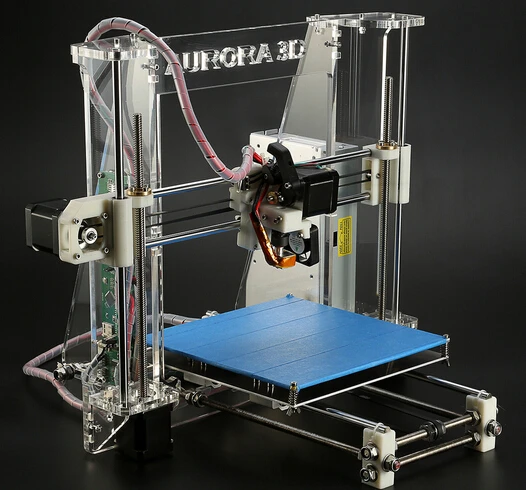
The video you see above is only the first test for Maxwell-Parish, in what he hopes will eventually be a successful concept for food printing. Whether this project ends successfully or not, it has accomplished two important tasks. It made us all chuckle a bit, and may be a stepping stone for an even better can-driven 3D printer…. Reddi-Wip anyone?
Let’s hear your thoughts on this creative, yet pretty comical 3D printing application. Discuss in the Easy Cheese 3D printer forum thread on 3DPB.com.
Stay up-to-date on all the latest news from the 3D printing industry and receive information and offers from third party vendors.
Tagged with: cheese 3d printer • cheese printer • easy cheese • easy cheese 3d printer • food 3d printer • Maxfield-Parish • reddi-wip
Please enable JavaScript to view the comments powered by Disqus.
90,000 characteristics, pros and cons of each model07.04.2021
Content
-
- What is a food 3D printer
- Field of use
- used raw materials
- 9000 9000 9000 9000
- Top 10 Best Food Printers: A List of the Most Current Models
- 1.
 PancakeBot 2.0
PancakeBot 2.0 - 2. Wiiboox Sweetin
- 3. Choc Creator V2.0 Plus
- 4. Choc Creator V2.0 Plus Food 3D Printer with Cooling Chamber
- 5. byFlow Focus
- 6. Chefjet Pro
- 7. Foodini
- 8. Mmuse – Chocolate 3D Printer Commercial ArtcakesOT7 .90BOT Printer F5
- 1.
- 10. ZMorph VX
- What is a food 3D printer
- Selection guide
- Output
A food printer is a high-tech device that is used to create culinary masterpieces. The decorative design of food products has reached a new level thanks to the use of modern technologies: high-quality and large-format printing is carried out on cakes, waffles, pancakes and even coffee. Here are the top best 3D food printers in different price categories for people who are fond of cooking.
What is a 3D food printer
The main feature of a food 3D printer is the raw materials used: instead of printing ink, the device is filled with edible ingredients. The database stores a large number of different recipes, and in order to print a dish, you just need to select one of them and activate the printing process. The final product is layered on a work surface or on a plate: it can be baked in the oven or sent to the freezer.
The database stores a large number of different recipes, and in order to print a dish, you just need to select one of them and activate the printing process. The final product is layered on a work surface or on a plate: it can be baked in the oven or sent to the freezer.
Application
Futuristic 3D Printed Sugar Candy
Cookies printed with icing
Chocolate logos of famous companies
Cream Photo Print
Buying a food 3D printer is worth the owners of coffee houses, author's bakeries and private workshops. The finished product has a unique shape and bright appearance. Food printers are often used to create custom wedding cakes, cartoon character cookies, Christmas gingerbread cookies, and so on. The possibilities of a baker who owns such a device are endless: the main thing is to buy quality products.
Raw materials used
The following ingredients are used as raw materials:
-
Chocolate without additives and impurities;
-
Mastic;
-
Sugar;
-
Whipped cottage cheese;
-
Vegetable and fruit pastes;
-
Fish and meat pates;
-
Flour;
-
Cheese, etc.

The confectionery pattern is applied to sugar, wafer or shock transfer paper. The first type has a sweetish aftertaste and aroma of vanilla. Due to the snow-white surface, no additional coating is required: the drawings look bright and clear. The wafer paper is made from rice flour and does not have a special taste, due to the light shade, the final drawings look less clear. Shock transfer paper is completely transparent and is suitable for transferring a design to a product (for example, a cake). For the packaging of finished products, food-grade plastic for a 3D printer is used.
Interesting! Food printers are involved in waste reduction. Unattractive fruit and confectionery leftovers are used in the preparation of printing mixes. This makes it possible to use the means of production more efficiently.
Types of 3D food printers
Cooking enthusiasts can take advantage of the following food printing devices:
-
Food 3D printers are devices that print dishes whose recipes are listed in a database.
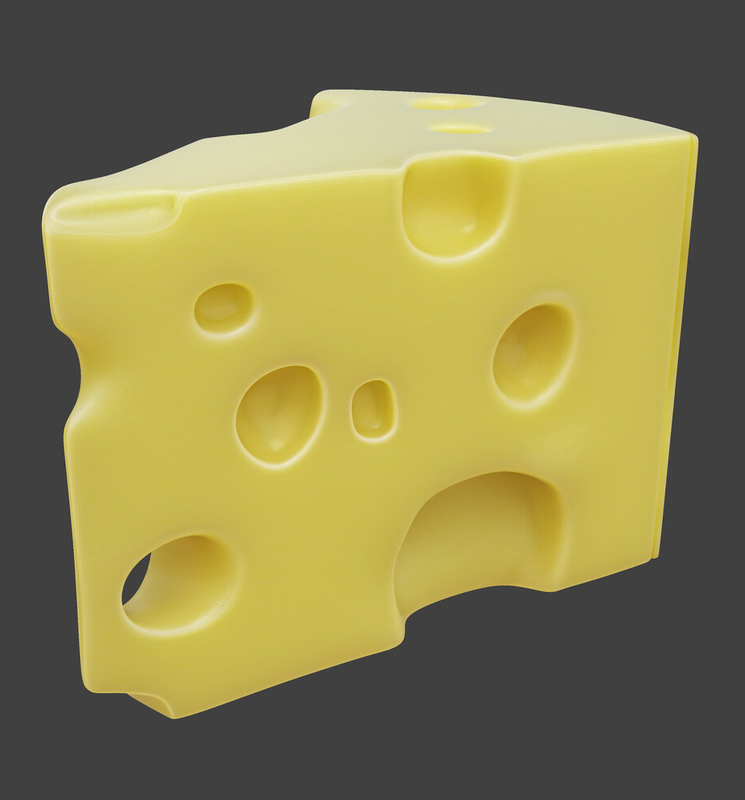 The final product is layer-by-layer superimposed on the work surface, and the raw material comes from filled cartridges;
The final product is layer-by-layer superimposed on the work surface, and the raw material comes from filled cartridges; -
Confectionery printers are used to transfer images onto specialty paper or to design small confectionery products such as candies. Such printers print an image on pre-prepared paper: rice, wafer or shock transfer;
-
Food plotters transfer the image not to paper, but directly to the finished product. For example, a plotter is used to transfer an image directly onto a cake.
There are several types of food 3D printers:
-
Extrusion - paint is applied to the surface before the dish is created. The process is controlled by the computer with the loaded image. The system has an extruder that heats the food mixture, and the distribution of raw materials depends on the print head. The raw material is loaded into a syringe placed in the head. This means that in order to combine different shades, you have to periodically stop printing and change the syringe;
-
A carousel-type food 3D printer also has an extruder, but its main feature is the method of feeding raw materials: the containers rotate around the working surface, the supply and dosage of the material used depends on the recipe specified in the program.
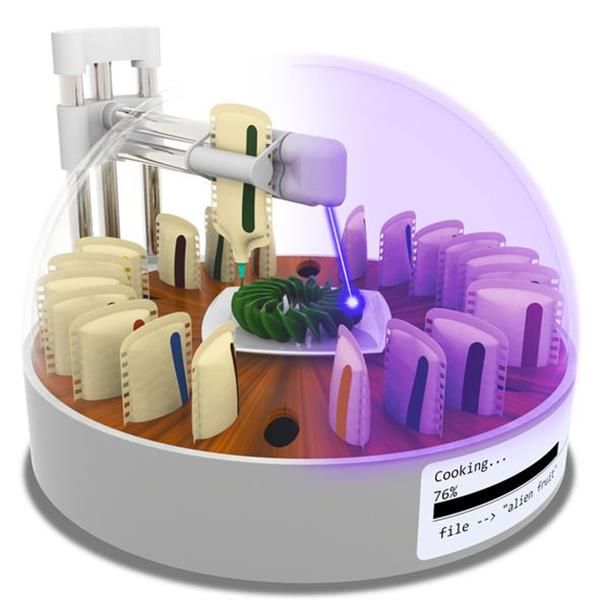 The storage can contain countless recipes, and operation does not cause difficulties even for an inexperienced user.
The storage can contain countless recipes, and operation does not cause difficulties even for an inexperienced user.
Popular brands
Eminent manufacturers offer the best value for money food 3D printer. Quality devices provide accurate printing, high speed, durability, simplicity and ease of use.
Wiibox
This company manufactures 3D printers with high build quality and high productivity. These are universal mechanisms that fill both chocolate paste and mashed potatoes. Numerous positive reviews confirm the high quality of Wiibox products.
byFlow
The Dutch company byFlow specializes in food printing technology. The pursuit of excellence helps the company open up new horizons: the technique prints products from spinach, meat emulsion and other materials. High build quality, ease of use and durability - all these characteristics are applicable to the products of this company.
Choc Edge
Choc Edge is committed to revolutionizing the world of chocolate making. Numerous experiments and focus on consumer feedback help to create more powerful devices that provide the optimal temperature for preparing and storing chocolate figures.
Numerous experiments and focus on consumer feedback help to create more powerful devices that provide the optimal temperature for preparing and storing chocolate figures.
Attention! Printing dishes helps save time on cooking: instead of culinary worries, the user can simply activate the printing process and get on with other things.
Free shipping
Add to compare
Item added to compare Go
| Manufacturer | Choc Edge |
Available on credit. To checkout, add the product to the cart and follow the instructions Go
| Manufacturer | Wiiboox |
Free Shipping
Add to compare
Item added to compare Go
| Manufacturer | Choc Edge |
Top 10 Best Food Printers: List of the Most Current Models
Before you buy a food 3D printer, you need to familiarize yourself with the most popular devices on the world market.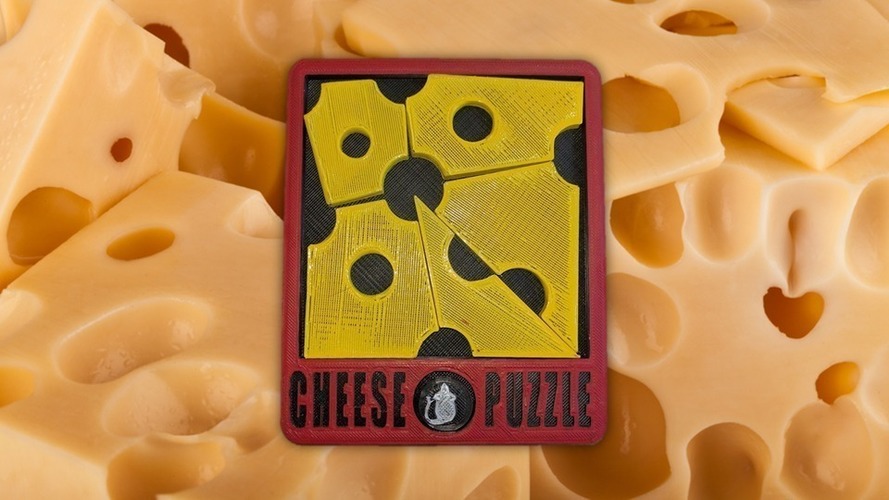 The top is based on ratings and customer reviews.
The top is based on ratings and customer reviews.
1. PancakeBot 2.0
PancakeBot 2.0 is easy to use, which means it's suitable for inexperienced users too. Users can choose from suggested designs in the software, or create their own. Used to print pancakes.
Pros:
-
Ease of operation;
-
A wide range of proposed projects;
-
High speed.
Cons:
2. Wiiboox Sweetin
Buying a food printer from Wiiboox is worth not only for confectionery lovers, but also for ordinary chefs: the device prints cakes, cookies and even mashed potatoes. The main raw materials can be meat, cheese, chocolate, jam, mashed potatoes, dough and much more. A convenient touch panel helps to set the desired mode of operation, and a stylish appearance complements the interior of any establishment.
Pros:
-
Versatility: the ability to print not only sweet dishes, but also side dishes;
-
Attractive appearance;
-
High build quality;
-
Convenient control by touch panel.

Cons:
-
High price.
3. Choc Creator V2.0 Plus
When talking about which chocolate 3D printer to buy, it is worth mentioning the numerous advantages of Choc Creator V2.0 Plus. The new model has become more perfect: the developers have worked hard to eliminate the shortcomings of the previous version. The modern model has small dimensions, thanks to which it can be used in any kitchen, and the uniform heating of the syringe ensures high-quality and uninterrupted operation. In practice, the chocolate printer has shown tremendous potential: it prints complex figures from chocolate.
Pros of :
-
Attractive appearance;
-
Uninterrupted work;
-
Durability;
-
The ability to create durable and beautiful chocolate figures.
Cons :
4.
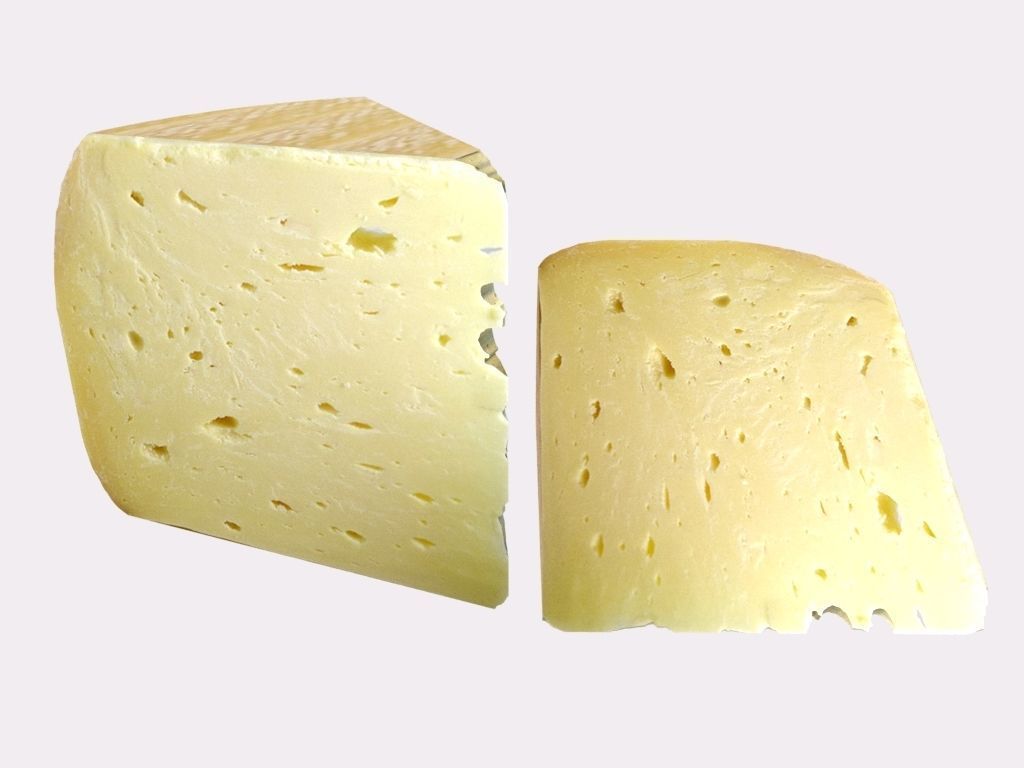 Choc Creator V2.0 Plus 3D food printer with cold chamber
Choc Creator V2.0 Plus 3D food printer with cold chamber
The new version of the Choc Creator V2.0 Plus printer is equipped with cooling chambers by popular demand. Users say that maintaining the optimal temperature in the room to preserve the integrity of chocolate figures is too problematic: therefore, the new device cools the raw materials. The price of a food 3D printer with a cooling system is slightly higher than a classic one, but the high performance of the final product justifies any costs.
Pros of :
-
Availability of a cooling system for finished products;
-
High printing precision;
-
Long service life;
-
Ease of use: You can turn the fans on and off with the side buttons.
Cons :
-
High price.
Attention! Confectionery food 3D printers are often used by artists to create edible masterpieces.
This is a unique technology that helps to unleash the creative potential of the chef.
5. byFlow Focus
Food printer from the Dutch company byFlow, which specializes in 3D printing of food. The compact high-tech device is used for the bakery industry, and the cartridges are suitable for the application of any pasty ingredients.
Pros:
Cons:
6. Chefjet Pro
Buying a ChefJet Pro food printer is a must for people who dream of making bright and stylish sweets. The device is created on the principle of inkjet printing: sugar-containing powder materials are used instead of paints. The final product is made by powder layering. The printer is suitable for combining different shades and creating gradients.
Pros:
-
The ability to create unique flavors;
-
Neat and bright printing;
-
Aesthetic appearance of the device.
Cons:
-
High price.
7. Foodini
The 3D food printer from Foodini works on the principle of a stationary printer, but instead of printing inks, layer-by-layer imposition of edible raw materials is used: dough, cream, chocolate, cream, etc. The device is versatile: the user himself can choose the material, or use ready-made cartridges with products.
Pros:
-
Practicality;
-
High build quality;
-
Attractive appearance;
-
Availability of an online platform with unique recipes.
Cons:
8. Mmuse – Chocolate 3D Printer
The closed MMuse 3D printer is suitable for chocolate printing. Chocolate beans are used as raw materials: they are heated in an extruder and fed to the work surface through the print head.
Pros:
Cons:
9. ZBOT Commercial Art Pancakes Printer F5
ZBOT Commercial Art Pancakes Printer F5 3D Printer
A food printer from Chinese manufacturers is used in the process of making pancakes of various shapes. Ease of operation allows the device to be used by children under adult supervision.
Pros:
-
Ease of operation;
-
High build quality;
-
Affordable cost.
Cons:
10. ZMorph VX
A multifunctional 3D printer capable of printing not only food, but also rubber, ABS plastic, polylactide, PVA, nylon, elastic and metal materials. The product is able to print with chocolate, butter, cookies, icing and other ingredients. In addition, there is a function of engraving and CNC milling.
Pros:
Cons:
-
High price.

Selection guide
The modern market offers a wide range of food printers. Before making a purchase, you need to carefully study the characteristics of each model and build on your own preferences. Experts have created several recommendations for choosing:
-
In case you want to create realistic images for confectionery 3D printing, pay attention to the diameter of the nozzle: the narrower it is, the more accurate the image will be;
-
It is better for people living in regions with a warm climate to purchase chocolate 3D printers with a cooling system: such devices ensure that the figurines are kept at the optimum temperature;
-
The possibility of self-refilling the cartridge is the most practical and economical way to operate the printer;
-
Print speed is an important consideration for restaurant owners. Large batches of dishes must be produced quickly, and for home use this is not a very strict selection criterion.

Output
In the catalog of our online store, you can choose the best food printers from famous brands to create culinary masterpieces. Explore our range, learn about the characteristics of each printer and make great purchases.
#Useful
Expert in the field of additive and subtractive technologies, 3D equipment and CNC machines with over 10 years of experience.
Share
all materials
Chocolate 3D printer in the catalog of food printers and components, food printing services
The main features of a simple FDM printer are those that replace traditional materials in 3D-druk (plastic) and vicorist pasta and cream for cooking hedgehogs - chocolate, dough, cheese, pasta, meat pate, vegetable and fruit sum . At the same time, the 3D printer extruder can be easily reconfigured to a traditional 3D printer from ABS, PLA, HIPS, PVA and others.
3D printer creates any kind of design from chocolate, syrup, pate, vegetable pastes and other food materials. Chocolate 3D is a miracle solution for HoReCa business, a small business solution for 3D other chocolate, dough, cheese, pastes, meat pate, vegetable and fruit sums and other things. You can also vicoristize your printer at home.
Chocolate 3D is a miracle solution for HoReCa business, a small business solution for 3D other chocolate, dough, cheese, pastes, meat pate, vegetable and fruit sums and other things. You can also vicoristize your printer at home.
Now for the help of special attachments for a #3D printer - you can use a test for baking or baking with one-hour baking, as well as work with a laser engraving oven, biscuits or other types.
Retailers have designed a modern extruder from a ball-bearing model, which can be developed not only from a PC, but also from a SD card and driven via Wi-Fi, with a speed of 30-50 mm / s and for a maximum ball thickness of 1 mm. It is easy for a traditional 3D-friend to achieve such results, especially in culinary craftsmanship, which may be of primary importance.
Learn - the printer is simple for a robot and is completely safe, learn how to use it and immediately master the skills of 3D modeling and you can teach a child to a friend.
Design - inexpensive stained glass materials, both among food products, and among a wide range of plastic thread, give the ability to win a model as well as the main tool of a designer, fashion designer, architect.



